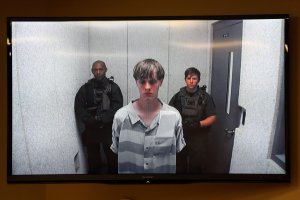Convicted Charleston church shooter Dylann Roof began making his case in court Wednesday as jurors weigh whether to give him a death sentence.
“There’s nothing wrong with me psychologically,” Roof said during his brief opening statement.

Three people who’d been sitting in the section of the courtroom reserved for friends and family of the victims walked out while Roof spoke. One said, “This is all crap,” as he left.
Roof, wearing a gray knit sweater and speaking so softly that people in the courtroom strained to hear him, told jurors to disregard the arguments his attorneys made in the earlier phase of the trial.
“Anything you heard from my lawyers in the last phase, I ask you to forget it,” he said. “That’s the last thing.”
Prosecutor details Roof’s jailhouse journal
Last month jurors convicted Roof of federal murder and hate crimes charges for the June 2015 massacre at Emanuel African Methodist Episcopal Church in Charleston.
Now the white supremacist who killed nine people at the historically black church is representing himself in court as the jury decides whether he will face life in prison or the death penalty.
Assistant US Attorney Nathan Williams argued Wednesday that a number of factors show Roof deserves to face a death sentence. Among them: the avowed white supremacist’s motive, the shooting’s impact on families and individuals and the gunman’s lack of remorse.
“The defendant didn’t stop after shooting one or four or five people. That’s why this case is worse,” Williams said. “He killed because of the color of their skin. He thought they were less as people. He wanted to magnify and incite violence.”
The prosecutor presented new evidence, including a jailhouse journal that he said was written six weeks after Roof’s arrest.
“I do not regret what I did,” the journal entry said, according to Williams. “I am not sorry. I have not shed a tear for the innocent people I killed. I do feel sorry for the innocent white children forced to live in this sick county. I do feel sorry for the innocent white people that are killed daily at the hands of the lower races. I have shed a tear of self-pity for myself. I feel pity that I had to do what I did in the first place. I feel pity that I had to give up my life because of a situation that should never have existed.”
The journal entry echoes racist statements from Roof that prosecutors presented earlier in the trial.
But the jailhouse writings reveal something significant, Williams argued.
Roof, the prosecutor said, is capable of remorse — but felt none.
Victims’ families torn
Some family members of victims appear torn over whether Roof should be sentenced to death.
Roof also is scheduled to be tried on state murder charges, for which he could also be sentenced to death.
Only three federal inmates have been executed in the United States since the federal death penalty was reinstated in 1988 after a 16-year moratorium:
• Oklahoma City bomber Timothy McVeigh on June 11, 2001, six years after he killed 168 people.
• Juan Raul Garza on June 19, 2001, eight years after he was convicted of running a marijuana drug ring and killing three people.
• Louis Jones on March 18, 2003, eight years after he kidnapped and murdered 19-year-old Army Pvt. Tracie McBride.
Boston Marathon bomber Dzhokhar Tsarnaev was the last person to get a federal death sentence. He’s one of 62 federal prisoners awaiting execution, according to the Death Penalty Information Center, a Washington-based nonprofit.






